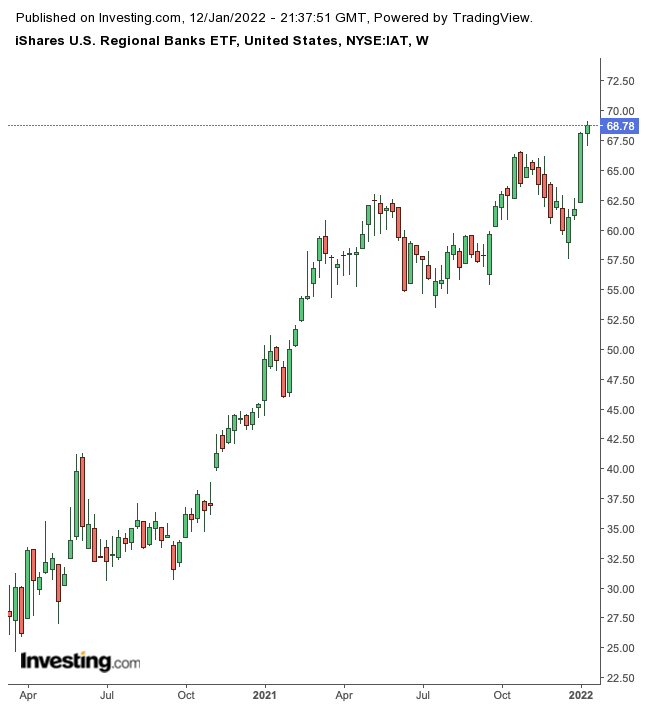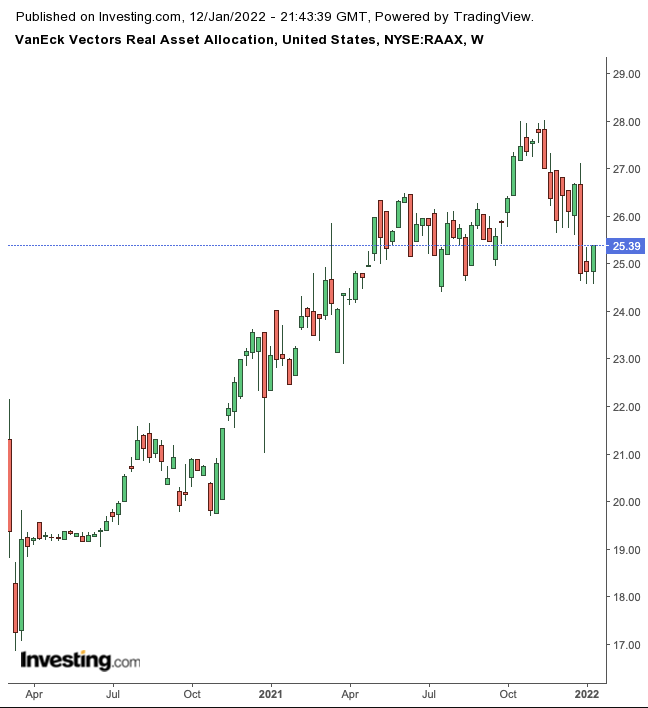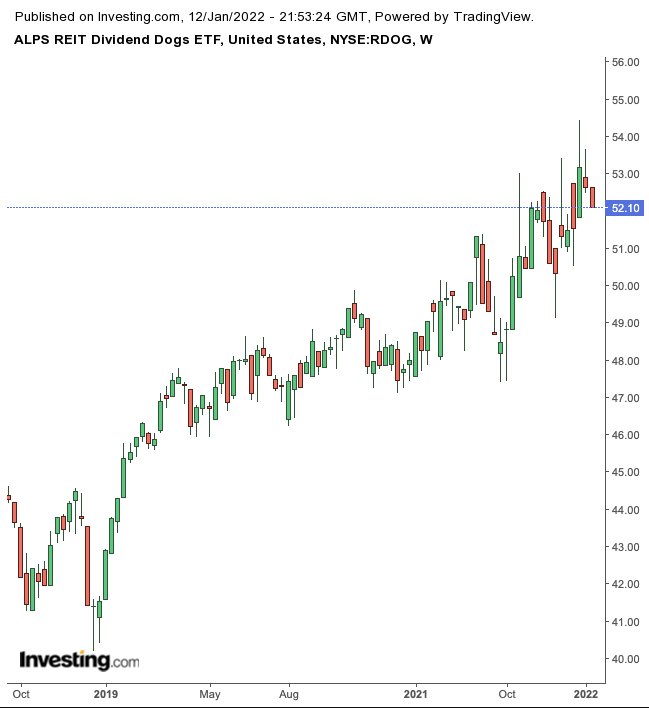At his Jan. 11 Senate confirmation hearing, Fed Chair Jerome Powell suggested that higher interest rates would be necessary to control inflation. He said:
“We will use our tools to support the economy and a strong labor market and to prevent higher inflation from becoming entrenched.”
With that in mind, today’s article introduces three exchange-traded funds (ETFs) that could benefit from a tighter Fed policy in the months ahead.
1. iShares U.S. Regional Banks ETF
- Current price: $68.78
- 52-Week Range: $45.90 - $68.84
- Dividend Yield: 1.71%
- Expense Ratio: 0.41% per year
Financial stocks, especially bank shares, are well-positioned to benefit from rising interest rates. For commercial banks, profits come primarily from interest payments from borrowers, which are higher than what they pay depositors.
Our first fund, the iShares U.S. Regional Banks ETF (NYSE:IAT), invests in small and mid-sized US regional bank stocks, which constitutes the more consumer-facing segment of the industry. The ETF started trading in May 2006, and net assets currently stand at $1.54 billion.

Through its 39 holdings, IAT tracks the Dow Jones US Select Regional Banks Index's returns. The fund is considered top-heavy, as its ten largest stocks account for over 65% of its value.
The leading names on the roster include PNC Financial Services (NYSE:PNC), Truist Financial Corp (NYSE:TFC), U.S. Bancorp (NYSE:USB), SVB Financial Group (NASDAQ:SIVB), and Fifth Third Bancorp (NASDAQ:FITB).
Fears over surging inflation and the anticipated increase in interest rates continue to drive IAT into all-time high (ATH) territory. The fund has seen a record recently, and it is currently up 10.6% year-to-date. In the past 12 months, it returned over 37.5%.
Trailing P/E and P/B ratios stand at 23.25x and 1.75x. Given the recent increase in price, potential investors could wait for short-term profit-taking before buying the fund.
2. VanEck Inflation Allocation ETF
- Current Price: $25.39
- 52-week Range: $22.46 - $28.02
- Dividend Yield: 5.4%
- Expense Ratio: 0.78% per year
When inflation is rising, seasoned investors add tangible assets to their portfolios. Such inflationary hedges may include commodities, natural resource stocks, financial shares, real estate investment trusts (REITs), master limited partnerships (MLPs), and infrastructure stocks. In addition, some investors now wonder whether cryptocurrencies like Bitcoin might also provide some protection against rising prices.
Our second fund, the VanEck Inflation Allocation (NYSE:RAAX), is a fund of funds that provides exposure to inflation-fighting real assets. It was launched in April 2018.

This fund currently has 23 holdings. The top ten ETFs in RAAX account for more than 78% of net assets of $32.7 million.
The top funds on its roster include:
Invesco Optimum Yield Diversified Commodity Strategy ETF (NASDAQ:PDBC), Vanguard Real Estate ETF (NYSE:VNQ), VanEck Merk Gold Shares (NYSE:OUNZ), Global X US Infrastructure Development ETF (NYSE:PAVE), and VanEck Energy Income ETF (NYSE:EINC).
RAAX gained 9.7% in the past 12 months. Furthermore, it supports a lucrative 5.4% dividend yield at current prices.
The ETF hit a record high in mid-November but has declined around 11% since then. Interested readers may use the recent dip as an opportunity to invest in the fund.
3. ALPS REIT Dividend Dogs ETF
- Current Price: $52.10
- 52-week Range: $39.96 – $54.44
- Dividend Yield: 3.03%
- Expense Ratio: 0.38% per year
Our final fund, the ALPS REIT Dividend Dogs ETF (NYSE:RDOG), offers high dividend exposure by focusing on the highest-yielding segments within the REIT space. We recently wrote about the “Dogs of the Dow” strategy and buying high dividend shares in various sectors.

This passively managed fund currently has 39 holdings. Net assets have grown over $28.8 million since its inception in May 2008. The top ten names account for a little more than 27% of the fund. As RDOG is equally weighted, moves in any individual stock do not significantly impact price.
National Health Investors (NYSE:NHI), Omega Healthcare Investors (NYSE:OHI), Industrial Logistics Properties Trust (NASDAQ:ILPT), SL Green Realty (NYSE:SLG), Vornado Realty Trust (NYSE:VNO), and Medical Properties Trust (NYSE:MPW) are among the leading REITs in the fund.
In terms of sectoral breakdown, Financial REITs dominate the fund with 17.34%, followed by Health Care REITs (13.58%) and Residential REITs (12.50%). It also includes a Technology REIT segment (7.28%) for exposure to increased digitalization trends. On the other hand, RDOG excludes the Mortgage REIT segment as they are likely to be more sensitive to interest rate changes.
The ETF hit a record high in the final week of 2021. The fund has gained around 30.6% over the past year. Moreover, RDOG offers a 3.0% dividend yield at current prices. Income investors might consider keeping RDOG on their radar and investing during the next pullback.
